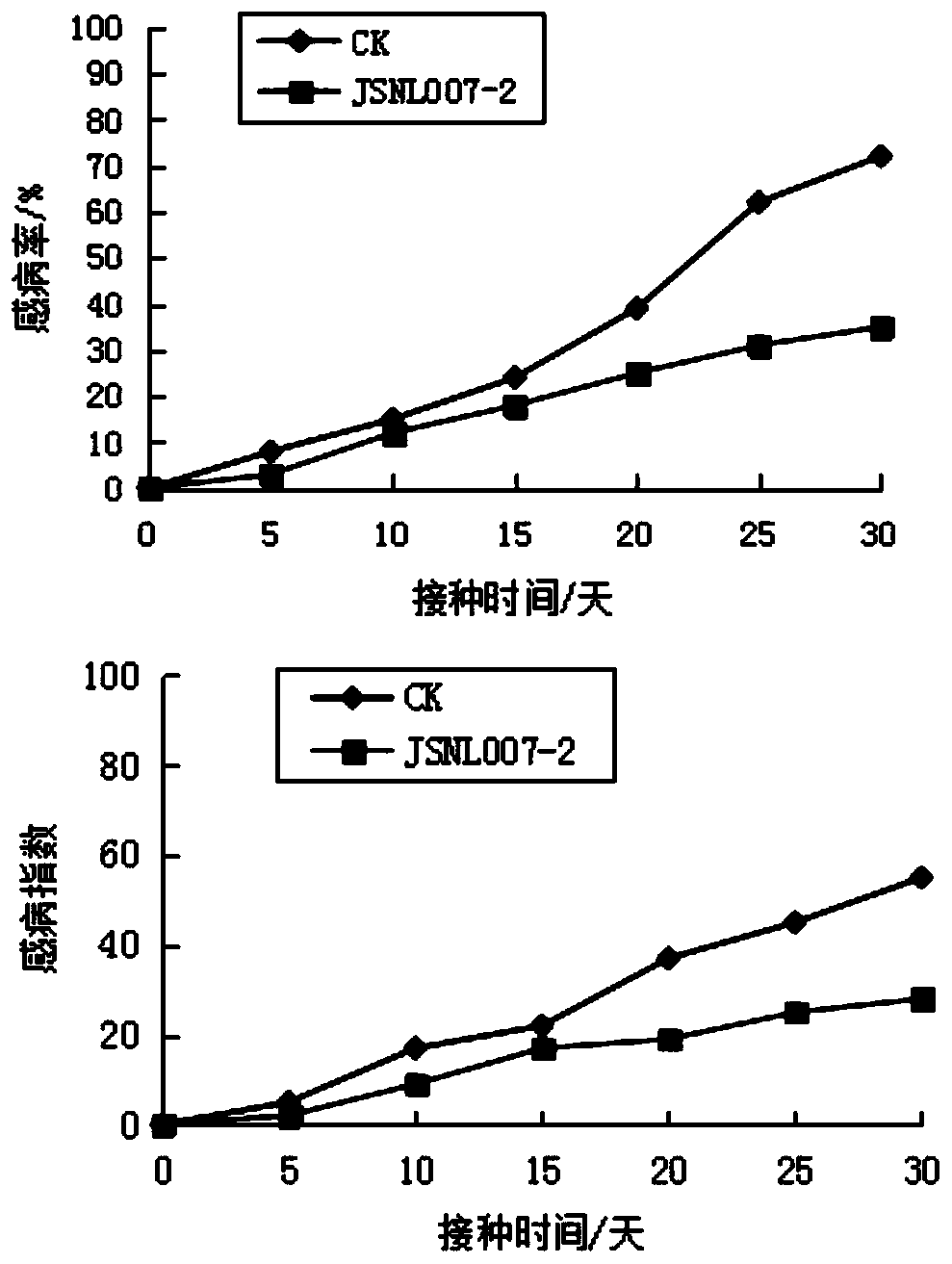A strain of Fusarium solani and its application in the control of Dendrobium officinale
A technology for Fusarium rot and Dendrobium candidum, which is applied in the field of microorganisms, can solve the problems of easy injury of Dendrobium candidum, great destructiveness, rapid onset, etc., achieves good development and application prospects, improves disease resistance, and has remarkable effects.
- Summary
- Abstract
- Description
- Claims
- Application Information
AI Technical Summary
Problems solved by technology
Method used
Image
Examples
Embodiment 1
[0023] A dendrobium candidum resistant strain JSNL007-2 was isolated and screened from the plants in the planting area of Dendrobium candidum in Jurong City, Jiangsu Province. It was cultured on a PDA plate. On the surface of the substrate; the opposite side is white to light yellow, with slight pigmentation, such as figure 1 shown.
[0024] The full sequence of the ITS region of the strain JSNL007-2 was amplified and sequenced, and the full sequence of the rDNA ITS sequence obtained by PCR amplification, as shown in SEQ ID No 1, was found by comparison on the genebank, and the results showed that the strain JSNL007-2 The homology with the Fusarium solani strain (Fusarium solani) is the closest, and the homology with the strains Fusarium solani LYF019 and Fusarium solani CDR3P2F2 both reached 99%. Combined with the morphological and physiological and biochemical characteristics, the strain JSNL007-2 was initially identified as Fusarium solani Fusarium solani (Fusarium solan...
Embodiment 2
[0026] Microbial agent produced by Fusarium solani (Fusarium solani) JSNL007-2:
[0027] (1) Using cottonseed shell fungus residue as the culture substrate, ammonium nitrate as the exogenous nitrogen source, and sucrose as the exogenous carbon source, prepare a solid culture substrate and put it in an autoclave bag, and put it in a high-pressure condition of 121 ° C and 101.3 kPa Sterilize under low temperature for 20-25 minutes, inoculate the mycorrhizal fungus JSNL007-2 under aseptic conditions after the culture medium is cooled, and then carry out artificial cultivation;
[0028] (2) Specific culture conditions for artificial culture at 25-30°C, 8 hours of light and 16 hours of darkness per day, and a pH of 6.0-6.5 for 5 to 8 days.
[0029] (3) Cut the solid microbial agent cultured in step (2) into 1-1.5cm 3 sized chunks, set aside.
Embodiment 3
[0031] Analysis of the effect of the microbial agent produced by Fusarium solani (Fusarium solani) JSNL007-2 on the disease resistance of Dendrobium officinale.
[0032] (1) artificially cultivate on the PDA medium, obtain the sclerotia of the white silkworm pathogen;
[0033] (2) The solid microbial bacterial agent cultivated in Example 2, and the sclerotium of the white silk disease pathogen cultivated in step (1), are inoculated on the surface of the cultivation substrate of Dendrobium candidum seedlings simultaneously, wherein, the JSNL007 of every clump of Dendrobium candidum seedlings -2 The inoculum amount of the solid bacterial agent is 5-8g, and the number of sclerotias of the pathogen of white silkworm is 10;
[0034] (3) After applying the bacterial agent, manage the Dendrobium officinale plants in step (2) under the same conditions, and maintain the relative water content of the substrate at least 6-10 days above 60%, so as to ensure that the mycelium survives in t...
PUM
 Login to View More
Login to View More Abstract
Description
Claims
Application Information
 Login to View More
Login to View More - R&D
- Intellectual Property
- Life Sciences
- Materials
- Tech Scout
- Unparalleled Data Quality
- Higher Quality Content
- 60% Fewer Hallucinations
Browse by: Latest US Patents, China's latest patents, Technical Efficacy Thesaurus, Application Domain, Technology Topic, Popular Technical Reports.
© 2025 PatSnap. All rights reserved.Legal|Privacy policy|Modern Slavery Act Transparency Statement|Sitemap|About US| Contact US: help@patsnap.com


